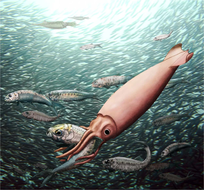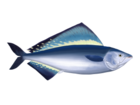Leptolepis
| Leptolepis Temporal range:
| |
|---|---|

| |
| Fossil specimen, National Museum of Natural History | |
| Scientific classification | |
| Domain: | Eukaryota |
| Kingdom: | Animalia |
| Phylum: | Chordata |
| Class: | Actinopterygii |
| Order: | †Leptolepiformes |
| Family: | †Leptolepidae |
| Genus: | †Leptolepis Agassiz, 1843 |
| Type species | |
| Cyprinus coryphaenoides Bronn, 1830
| |
Leptolepis (from Greek: λεπτός leptós, 'slight' and Greek: λεπίς lepis 'scale')[1] is an extinct genus of stem-teleost fish that lived in what is now Europe (Germany, Luxembourg, France, England, Italy and maybe Greece)[2][3][4][5] and North of Africa (Algeria, Tunisia and Morocco) during the Jurassic period (Pliensbachian–Callovian ages).[6][7][8]
Taxonomy
[edit]The genus Leptolepis was for a long time used as a wastebasket taxon for various small, unspecialised teleosts that did not form a natural clade. In 1974 the Swedish ichthyologist Orvar Nybelin revised the genus, restricting it to seven species from the Early to Middle Jurassic of Europe. Other species were reassigned to different genera.[2]
- Leptolepis autissiodorensis Sauvage, 1892
- Leptolepis buttenheimensis Schwarzhans & Keupp, 2022[9]
- Leptolepis coryphaenoides (Bronn, 1830)
- Leptolepis curvisulcatus Schröder, 1956
- Leptolepis flexuosus Schwarzhans & Wakefield, 2024[10]
- Leptolepis jaegeri Agassiz, 1832
- Leptolepis kremmeldorfensis Schröder, 1956
- Leptolepis inaequalis Weiler, 1954
- Leptolepis nathorsti Woodward, 1900
- Leptolepis macrocephalus Schröder, 1956
- Leptolepis normandica Nybelin, 1962
- Leptolepis saltviciensis Simpson, 1855
- Leptolepis skyensis Schwarzhans & Wakefield, 2024[10]
- Leptolepis steberae Schwarzhans & Keupp, 2022[9]
- Leptolepis woodwardi Nybelin, 1974
Species formerly placed in Leptolepis
[edit]- Leptolepis talbragarensis Woodward, 1895 (Now referred to Cavenderichthys)
- Leptolepis koonwarri Waldman, 1971 (Now referred to Waldmanichthys)[11]
The type species Leptolepis coryphaenoides is placed as a stem-group Teleost.
Cladogram of Teleosteomorpha after Sferco et al. 2021:[12]
| Teleostei total group (Teleosteomorpha) |
| |||||||||||||||||||||||||||||||||||||||||||||||||||||||||||||||||||||||||||
Appearance
[edit]
Length of Leptolepis was about 8.5 centimetres (3.3 in) long,[13] and superficially resembled the unrelated modern herring. While more basal teleosts such as Pholidophorus had skeletons composed of a mixture of bone and cartilage, Leptolepis resembled modern teleosts in possessing a skeleton completely made of bone.[14] Another modern development in Leptolepis were its cycloid scales, which lacked the covering of ganoine present in more basal teleosts. These two developments made swimming easier, as the bony spine was now more resistant to the pressure caused by the S movements made while swimming.[15]
Mass graves of Leptolepis have indicated that species probably lived in schools which would provide some protection from predators while the creatures fed on surface plankton. Pelagosaurus was a known predator of Leptolepis, as a Pelagosaurus fossil was found with Leptolepis remains in its stomach.[16] Clarkeiteuthis is known from three specimens with Leptolepis in its arms, which estimate that Leptolepis is probably most common prey of Clarkeiteuthis. The Pterosaur Dorygnathus preserves remains of Leptolepis in its stomach.[17]
The Morrison cf. Leptolepis
[edit]Known only from a single nearly complete skeleton found at Rabbit Valley, Colorado.[18] A 13 centimetres (5 in) fish that was deeper bodied than its co-occurring contemporaries Morrolepis and Hulettia.[18] The Morrison cf. Leptolepis probably had a live mass of about 37 grams (1.3 oz).[18] It is the only teleost fish known from the formation and was morphologically more highly derived than other Morrison fish.[18] A specific example of apomorphy in cf. Leptolepis is its "more modern tail structure" compared to Morrolepis.[18] It is believed to have fed on fish and small invertebrates.[18]
References
[edit]- ^ Roberts, George (1839). An etymological and explanatory dictionary of the terms and language of geology. London: Longman, Orme, Brown, Green, & Longmans. p. 115. Retrieved 31 December 2021.
- ^ a b Konwert, M.; Stumpf, S. (2017). "Exceptionally preserved Leptolepidae (Actinopterygii, Teleostei) from the late Early Jurassic Fossil-Lagerstätten of Grimmen and Dobbertin (Mecklenburg-Western Pomerania, Germany)". Zootaxa. 4243 (2): 249–296. doi:10.11646/zootaxa.4243.2.2. PMID 28610149.
- ^ Delsate, D. (1999). "L'Ichthyofaune du Toarcien luxembourgeois" (PDF). Travaux Scientifiques du Musée National d'Histoire Naturelle de Luxembourg.
- ^ Tintori, A. (1977). "Toarcian fishes from the Lombardian basin". Bolletino della Società Paleontologica Italiana. 16 (4): 143–152. Retrieved 10 May 2022.
- ^ Argyriou, Thodoris (2022), "The Fossil Record of Ray-Finned Fishes (Actinopterygii) in Greece", Fossil Vertebrates of Greece Vol. 1, Cham: Springer International Publishing, pp. 91–142, doi:10.1007/978-3-030-68398-6_4, ISBN 978-3-030-68397-9, retrieved 2024-09-17
- ^ Gaudant, J.; Rakus, M.; Stranik, Z. (1972). "Leptolepis (Poisson teleosteen) dans le Toarcien de la Dorsale tunisienne". Notes du Service Géologique de Tunisie. 38 (1): 5–20.
- ^ Ettaki, Mohammed; Chellaï, El Hassane (2005-06-13). "Le Toarcien inférieur du Haut Atlas de Todrha–Dadès (Maroc) : sédimentologie et lithostratigraphie". Comptes Rendus. Géoscience. 337 (9): 814–823. Bibcode:2005CRGeo.337..814E. doi:10.1016/j.crte.2005.04.007. ISSN 1778-7025.
- ^ Murray, A.M. (2000). "The Palaeozoic, Mesozoic and Early Cenozoic fishes of Africa". Fish and Fisheries. 1 (2): 111–145. Bibcode:2000AqFF....1..111M. doi:10.1046/j.1467-2979.2000.00015.x. ISSN 1467-2960.
- ^ a b Schwarzhans, Werner; Keupp, Helmut (2022-04-12). "Early teleost otolith morphogenesis observed in the Jurassic of Franconia, Bavaria, southern Germany". Zitteliana. 96: 51–67. doi:10.3897/zitteliana.96.81737. ISSN 2747-8106.
- ^ a b Schwarzhans, W. W.; Wakefield, M. I. (2024). "Otoliths from the Lealt Shale Formation, Great Estuarine Group, Middle Jurassic (Bathonian), Inner Hebrides, Scotland". Scottish Journal of Geology. 60 (2): 002. Bibcode:2024ScJG...60....2S. doi:10.1144/sjg2024-002.
- ^ Sferco, Emilia, Adriana López-Arbarello, and Ana María Báez. "Phylogenetic relationships of† Luisiella feruglioi (Bordas) and the recognition of a new clade of freshwater teleosts from the Jurassic of Gondwana." BMC Evolutionary Biology 15.1 (2015): 1.
- ^ Sferco, Emilia; López-Arbarello, Adriana; Báez, Ana María (December 2015). "Phylogenetic relationships of †Luisiella feruglioi (Bordas) and the recognition of a new clade of freshwater teleosts from the Jurassic of Gondwana". BMC Evolutionary Biology. 15 (1): 268. Bibcode:2015BMCEE..15..268S. doi:10.1186/s12862-015-0551-6. ISSN 1471-2148. PMC 4668602. PMID 26630925.
- ^ Cavin, Lionel; Piuz, André; Ferrante, Christophe; Guinot, Guillaume (2021-06-03). "Giant Mesozoic coelacanths (Osteichthyes, Actinistia) reveal high body size disparity decoupled from taxic diversity". Scientific Reports. 11 (1): 11812. Bibcode:2021NatSR..1111812C. doi:10.1038/s41598-021-90962-5. ISSN 2045-2322. PMC 8175595. PMID 34083600.
- ^ The virtual petrified wood museum
- ^ Palmer, D., ed. (1999). The Marshall Illustrated Encyclopedia of Dinosaurs and Prehistoric Animals. London: Marshall Editions. p. 39. ISBN 1-84028-152-9.
- ^ Pierce, Stephanie E.; Benton, Michael J. (2006). "Pelagosaurus typus Bronn, 1841 (Mesoeucrocodylia: Thalattosuchia) from the Upper Lias (Toarcian, Lower Jurassic) of Somerset, England" (PDF). Journal of Vertebrate Paleontology. 26 (3): 621–635. doi:10.1671/0272-4634(2006)26[621:PTBMTF]2.0.CO;2. S2CID 131524957.
- ^ Cooper, Samuel. L. A.; Smith, R. E.; Martill, D. M. (2024). "Dietary tendencies of the Early Jurassic pterosaurs Campylognathoides Strand, 1928, and Dorygnathus Wagner, 1860, with additional evidence for teuthophagy in Pterosauria". Journal of Vertebrate Paleontology. 44 (2). doi:10.1080/02724634.2024.2403577.
- ^ a b c d e f Foster, J. (2007). "cf. Leptolepis." Jurassic West: The Dinosaurs of the Morrison Formation and Their World. Indiana University Press. p. 135.
Bibliography
[edit]- Silva Santos, R. (1958) - Leptolepis diasii, novo peixe fossil da Serra do Araripe, Brasil”. Boletim da Divisa˜o de Geologia e Mineralogia do Departamento Nacional de Produc¸a˜o Mineral, Notas Preliminares, Brazil 108, 1–15. o, Kiadó: Departamento Nacional de Produc¸a˜o Mineral.
- Maisey, J.. Santana fossils, an illustrated atlas. Neptune City, New Jersey, USA: T.F.H. Publications (1991)
- Silva Santos, R. (1995) - Santanichthys, novo epı´teto gene´rico para Leptolepis diasii Silva Santos, 1958 (Pisces, Teleostei) da Formac¸a˜o Santana (Aptiano), Bacia do Araripe, NE do Brasil”. Anais da Academia Brasileira de Cieˆncias, Brazil 67, 249–258. o, Kiadó: Academia Brasileira de Cieˆncias.
- Filleul, Arnaud, John G. Maisey (2004) - Redescription of Santanichthys diasii (Otophysi, Characiformes) from the Albian of the Santana Formation and Comments on Its Implications for Otophysan Relationships”. American Museum Novitates, New York, NY, USA 3455, American Museum of Natural History
- Prehistoric teleostei
- Prehistoric ray-finned fish genera
- Toarcian genus first appearances
- Bathonian genera
- Callovian genus extinctions
- Jurassic bony fish
- Jurassic fish of Europe
- Jurassic England
- Jurassic France
- Jurassic Germany
- Jurassic Italy
- Jurassic Norway
- Fossils of England
- Fossils of France
- Fossils of Germany
- Fossils of Italy
- Fossils of Norway
- Fossil taxa described in 1843
- Taxa named by Louis Agassiz





